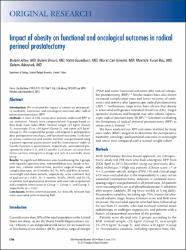| dc.contributor.author | Altay, Bülent | |
| dc.contributor.author | Erkurt, Bülent | |
| dc.contributor.author | Güzelburç, Vahit | |
| dc.contributor.author | Kiremit, Murat Can | |
| dc.contributor.author | Boz, Mustafa Yücel | |
| dc.contributor.author | Albayrak, Selami | |
| dc.date.accessioned | 10.07.201910:49:13 | |
| dc.date.accessioned | 2019-07-10T19:51:37Z | |
| dc.date.available | 10.07.201910:49:13 | |
| dc.date.available | 2019-07-10T19:51:37Z | |
| dc.date.issued | 2015 | en_US |
| dc.identifier.citation | Altay, B., Erkurt, B., Güzelburç, V., Kiremit, M. C., Boz, M. Y. ve Albayrak, S. (2015). Impact of obesity on functional and oncological outcomes in radical perineal prostatectomy. Canadian Urological Association Journal, 9(11-12), E766-E769. https://dx.doi.org/10.5489/cuaj.3094 | en_US |
| dc.identifier.issn | 1911-6470 | |
| dc.identifier.issn | 1920-1214 | |
| dc.identifier.uri | https://dx.doi.org/10.5489/cuaj.3094 | |
| dc.identifier.uri | https://hdl.handle.net/20.500.12511/2251 | |
| dc.description | WOS: 000373177500002 | en_US |
| dc.description | PubMed ID: 26600881 | en_US |
| dc.description.abstract | Introduction: We evaluated the impact of obesity on perioperative morbidity, functional, and oncological outcomes after radical perineal prostatectomy (RPP). Methods: A total of 298 consecutive patients underwent RPP at our institution. Patients were categorized into 3 groups based on their body mass index (BMI): Normal weight < 25 kg/m(2) (Group 1), overweight 25 to < 30 kg/m(2) (Group 2), and obese >= 30 kg/m(2) (Group 3). We compared the groups with respect to perioperative data, postoperative oncologic, and functional outcomes. Evaluation of urinary continence and erectile function was performed using a patient-reported questionnaire and the International Index of Erectile Function-5 questionnaire, respectively, administered pre-operatively and at 3, 6, and 12 months. Limitations included short follow-up time, retrospective design and lack of a morbidly obese group. Results: No significant differences were found among the 3 groups with regard to operative time, estimated blood loss, length of hospital stay, catheter removal time, positive surgical margin, and complication rates. At 12 months, 94.7%, 95% and 95% of normal, overweight and obese patients, respectively, were continent (free of pad use) (p = 0.81). At 12 months, 30.6%, 29.8% and 30.4% of patients had spontaneous erections and were able to penetrate and complete intercourse in Group 1, Group 2, and Group 3, respectively (p = 0.63). Conclusions: In this cohort of patients, no clinically relevant risks were associated with increasing BMI. | en_US |
| dc.language.iso | eng | en_US |
| dc.publisher | Canadian Urological Association | en_US |
| dc.rights | info:eu-repo/semantics/openAccess | en_US |
| dc.subject | Impact of Obesity | en_US |
| dc.subject | Radical Perineal Prostatectomy | en_US |
| dc.title | Impact of obesity on functional and oncological outcomes in radical perineal prostatectomy | en_US |
| dc.type | article | en_US |
| dc.relation.ispartof | Canadian Urological Association Journal | en_US |
| dc.department | İstanbul Medipol Üniversitesi, Tıp Fakültesi, Cerrahi Tıp Bilimleri Bölümü, Üroloji Ana Bilim Dalı | en_US |
| dc.authorid | 0000-0001-9988-2944 | en_US |
| dc.authorid | 0000-0002-0159-2090 | en_US |
| dc.authorid | 0000-0002-4245-7506 | en_US |
| dc.identifier.volume | 9 | en_US |
| dc.identifier.issue | 11-12 | en_US |
| dc.identifier.startpage | E766 | en_US |
| dc.identifier.endpage | E769 | en_US |
| dc.relation.publicationcategory | Makale - Uluslararası Hakemli Dergi - Kurum Öğretim Elemanı | en_US |
| dc.identifier.doi | 10.5489/cuaj.3094 | en_US |
| dc.identifier.wosquality | Q4 | en_US |
| dc.identifier.scopusquality | Q4 | en_US |


















